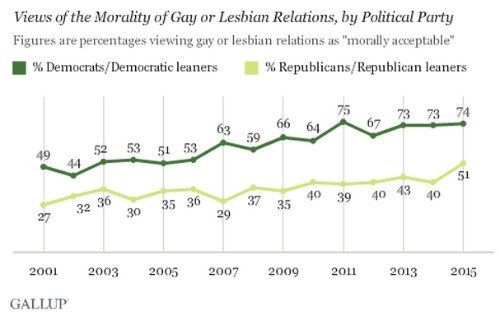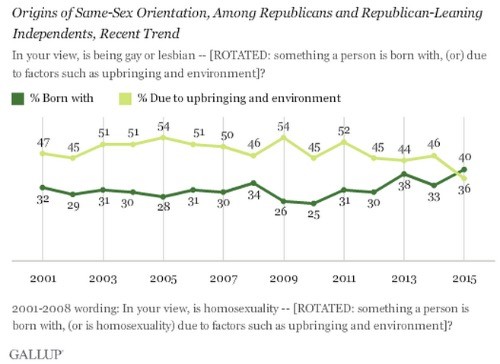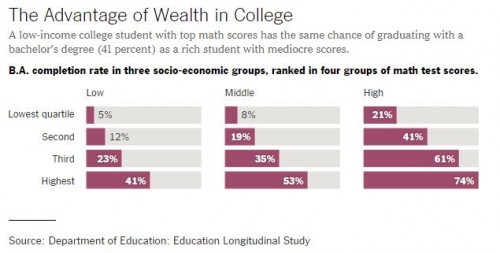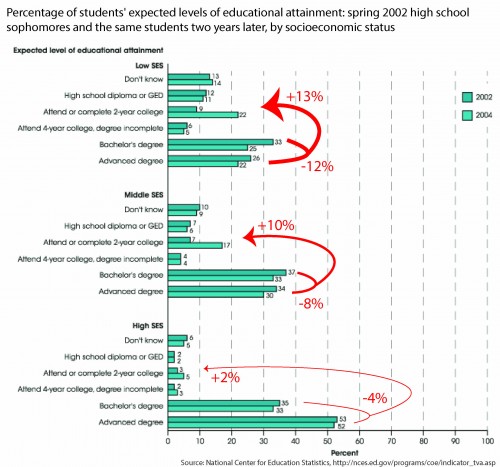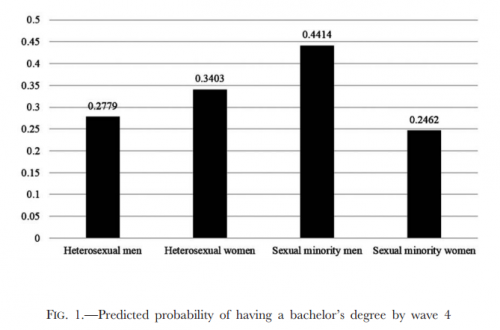 Well done, Sociopress!
Well done, Sociopress!
A Gallup poll of a random sample of Americans conducted in May finds that, for the first time, a majority of Republicans report that they believe that gay and lesbian relations are “morally acceptable.” This is your image of the week:
And this, showing that a plurality of Republicans — meaning more than not — think sexual orientation is inborn, not chosen or learned:
Now, to be fair, Gallup specifies a sampling error of ±4 percentage points. So, they’re 95% confident that at least 47% of Republicans now approve of gayness, but also as many as 55%. Also, I don’t know what “gay and lesbian relations” means — sexual relations? relationships? — and neither do the pollsters or the respondents, as far as I know, which is some interesting slippery question asking. Still, that’s the data. Here’s some skepticism, just in case you’ve got an eyebrow raised.
Lisa Wade, PhD is an Associate Professor at Tulane University. She is the author of American Hookup, a book about college sexual culture; a textbook about gender; and a forthcoming introductory text: Terrible Magnificent Sociology. You can follow her on Twitter and Instagram.Flashback Friday.
Many sociologists argue that gender, as we know it, is not innate, but put on and performed. Certain moments of our lives, like weddings and quinceañeras, are opportunities to really emphasize femininity and masculinity; but gender is also performed in mundane ways every day in the ways that we talk, move, dress, and adorn ourselves.
These photographs of child beauty pageant participants, taken by Susan Anderson and published in her book High Glitz, illustrate how much of feminine sexual allure is put on and performed. These kids are adultified with make-up and they also often wear false teeth and hair extensions. You can browse additional images at Powerhouse Books.

People often object to this sort of adornment on a child being unnatural, but when adult women use these same strategies — fake eyelashes, makeup, veneers, and hair extensions — it is no more natural. Adult women are, no less than those kids, performing femininity.
To take it one step further, as The Spinster Aunt does, if you react to the idea of child beauty pageants with horror, then than horror should be applied to the project of femininity itself, not just the fact that children are participants:
I submit that anyone who is uncomfortable with [the] Little Miss Perfect [pageant] is ethically obliged to be just as uncomfortable with femininity in general. Little Miss Perfect is merely one of a gazillion equally nauseating points on the Porno-Feminine Continuum within which all female citizens of the globe are confined by a culture of oppression.
So, if it’s troubling when girls do it (and, for that matter, also troubling to many when men do it), then why isn’t it troubling when women do it?
Originally posted in 2010.
Lisa Wade, PhD is an Associate Professor at Tulane University. She is the author of American Hookup, a book about college sexual culture; a textbook about gender; and a forthcoming introductory text: Terrible Magnificent Sociology. You can follow her on Twitter and Instagram.There is new research from the National Center for Education Statistics (NCES), written up by Susan Dynarsky at the New York Times Upshot. The striking finding is that poor children in the top quartile on high school math scores have a 41% chance of finishing a BA degree by their late twenties — the same chance as children from the second-lowest quartile in math scores who are high-socioeconomic status (SES). Poor children from the third-highest quartile in high school math have graduation about equal to the worst-scoring children form the richest group. Here’s the figure:
The headline on the figure is misleading, actually, since SES is not measured by wealth, but by a combination of parental education, occupation, and income. (Low here means the bottom quartile of SES, Middle is the 25th to 75th percentile, and High is 75th and up.)
One possible mechanism for the disparity in college completion rates is education expectations. Dynarsky mentions expectations measured in the sophomore year of high school, which was 2002 for this cohort. What she doesn’t mention is how much those expectations changed by senior year. Going to the NCES source for that data (here) I found this chart, which I annotated in red:
Between sophomore and senior year, the percentage expecting to finish a BA degree or more decreased and the percentage expecting to go to two-year college increased, across SES levels. But the change was much greater for lower SES students. So the gap in expecting to go to two-year college between high- and low-SES students grew from 6 to 17 percentage points; that is, from 9% versus 3% in the sophomore year to 22% versus 6% in the senior year.
That’s a big crushing of expectations that happened in the formative years at the end of high school.
Cross-posted at Family Inequality.
Philip N. Cohen is a professor of sociology at the University of Maryland, College Park. He writes the blog Family Inequality and is the author of The Family: Diversity, Inequality, and Social Change. You can follow him on Twitter or Facebook.
We’ve highlighted the really interesting research coming out of the dating site OK Cupid before. It’s great stuff and worth exploring:
- Common lies in online profiles
- Evidence that we care waaaaaaay too much about looks
- Sex, desirability, and age: what they say and what they do
- Only 20% of self-identified bisexuals message both men and women
- Does similarity really translate into compatibility?
- How useful is the concept of sexual orientation?
- Word clouds by race and gender reveal most commonly mentioned ideas
All of those posts offer neat lessons about research methods, too. And so does the video below of co-founder Christian Rudder talking about how they’ve collected and used the data. It might be fun to show in research methods classes because it raises some interesting questions like: What are different kinds of social science data? How can/should we manipulate respondents to get it? What does it look like? How can it be used to answer questions? Or, how can we understand the important difference between having the data and doing an interpretation of it? That is, the data-don’t-speak-for-themselves issue.
Lisa Wade, PhD is an Associate Professor at Tulane University. She is the author of American Hookup, a book about college sexual culture; a textbook about gender; and a forthcoming introductory text: Terrible Magnificent Sociology. You can follow her on Twitter and Instagram.For every man that earns a college degree, nearly two women will. Women have been outperforming men in college since they started attending in the 1920s, but thanks to widening opportunities, an economy that draws women in the workforce, and simple female ambition, women now outnumber men, too.
New research suggests, however, that the opposite is true for sexual minority men and women. Education researcher Leigh Fine asked whether the college graduation rates of gay, lesbian, and bisexual men and women reflected what we see in general. His respondents were 30 years old, on average — that is, old enough to have passed the age where most Americans complete their education — and they self-identified as non-heterosexual.
He found that the pattern we see in which women are more likely to earn a bachelor’s degree is reversed among sexual minorities. Gay and bisexual men are more likely to report graduating than lesbian and bisexual women. In fact, they’re more likely to report graduating than heterosexual men and women as well.
In contrast, sexual minority women were the least likely of all four groups to report graduating.
Running some fancy numbers — it was pretty tricky because of the low numbers of sexual minority respondents — Fine concludes that what we are seeing is a pattern among sexual minority women that is statistically similar to heterosexual men and a pattern among sexual minority men that is statistically similar to heterosexual women.
This is another great example of the importance of doing intersectional research. Sociologists use the term intersectionality to draw attention to the way that our identities — our race, gender, class, sexual orientation, immigration status, etc — never influence our lives in isolation from one another. They’re in cahoots. So, being female is one thing, but being a woman who sleeps with women is an entirely different thing, and being such a woman who lives in the country, carries a disability, or is a transnational migrant is entirely another. We’ve got a pretty interesting set of over 300 related posts at our intersectionality tag. Enjoy!
H/t to Education and Society. Cross-posted at Gender and Society.
Lisa Wade, PhD is an Associate Professor at Tulane University. She is the author of American Hookup, a book about college sexual culture; a textbook about gender; and a forthcoming introductory text: Terrible Magnificent Sociology. You can follow her on Twitter and Instagram.SocImages News:
Thanks to everyone who put up with a light month at the blog. For the first time in more than five years, the blog went without a post for more than one day — and I’m still catching up on social media. That’s what finishing up a semester and moving across country will do, I suppose. I’m now gleefully living in the terrible and magnificent city of New Orleans. I am still a professor at Occidental College, but I’m on leave for two years to finish a book about hookup culture and get started on an Introduction to Sociology textbook.
I’d love to travel this year and share my research on hookup culture with college students across the country. I’ve booked a few talks already, but would love to do more!
But enough about me…
You like! Here are our most appreciated posts this month:
- Men value independence in their daughters more than their wives (2,100+ likes)
- The unbearable daintiness of women who eat with men (750+ likes)
- The relative importance of poverty and sex to Catholicism (650+ likes)
- Whether you call it protest or rioting may depend on your race (600+ likes)
- Six decades of increasing partisanship in the U.S. House of Representatives (500+ likes)
Thanks everybody!
Editor’s picks:
- Higher black mortality and the outcome of elections
- Does the finance industry benefit society? A new analysis says no
- Don Draper and the pursuit of loneliness
- The politics of facial hair
Top post on Tumblr this month!
- A deliberate, considered kind of cruelty: Defensive architecture aimed at the homeless (7,500+ likes and shares)
Social Media ‘n’ Stuff:
Finally, this is your monthly reminder that SocImages is on Twitter, Facebook, Tumblr, Google+, and Pinterest. I’m on Facebook and most of the team is on Twitter: @lisawade, @gwensharpnv, @familyunequal, and @jaylivingston.
Lisa Wade, PhD is an Associate Professor at Tulane University. She is the author of American Hookup, a book about college sexual culture; a textbook about gender; and a forthcoming introductory text: Terrible Magnificent Sociology. You can follow her on Twitter and Instagram.
Recently we ran a graph showing the evolution of facial hair trends starting in 1842. It showed that about 90% of men wore facial hair in the late 1800s, but it was a trend that would slowly die. By 1972, when the research was published, almost as many were clean shaven.
So, why did facial hair fall out of fashion?
Sociologist Rebekah Herrick gives us a hypothesis. With Jeanette Mendez and Ben Pryor, she investigated the stereotypes associated with men’s facial hair and the consequences for U.S. politicians. Facial hair is rare among modern politicians. “Currently,” they noted, “fewer than five percent of the members of the U.S. Congress have beards or mustaches” and no president has sported facial hair since William Howard Taft left office in 1913, before women had the right to vote.
Using an experimental method, Herrick and her colleagues showed people photographs of similarly appearing politicians with and without facial hair, asking them how they felt about the men and their likely positions. They found that potential voters perceived men with facial hair to be more masculine and this was a double edged sword. Higher ratings of masculinity were correlated with perceptions of competence, but also concerns that the politicians were less friendly to women and their concerns.
In other words, the more facial hair, the more people worry that a politician might be sexist:
In reality, facial hair has no relationship to a male politician’s voting record. They checked. The research suggests, though, that men in politics — maybe even all men — would be smart to pay attention to the stereotypes if they want to influence how others see them.
Thanks to my friend, Dmitriy T.C., for use of his face!
Lisa Wade, PhD is an Associate Professor at Tulane University. She is the author of American Hookup, a book about college sexual culture; a textbook about gender; and a forthcoming introductory text: Terrible Magnificent Sociology. You can follow her on Twitter and Instagram.
